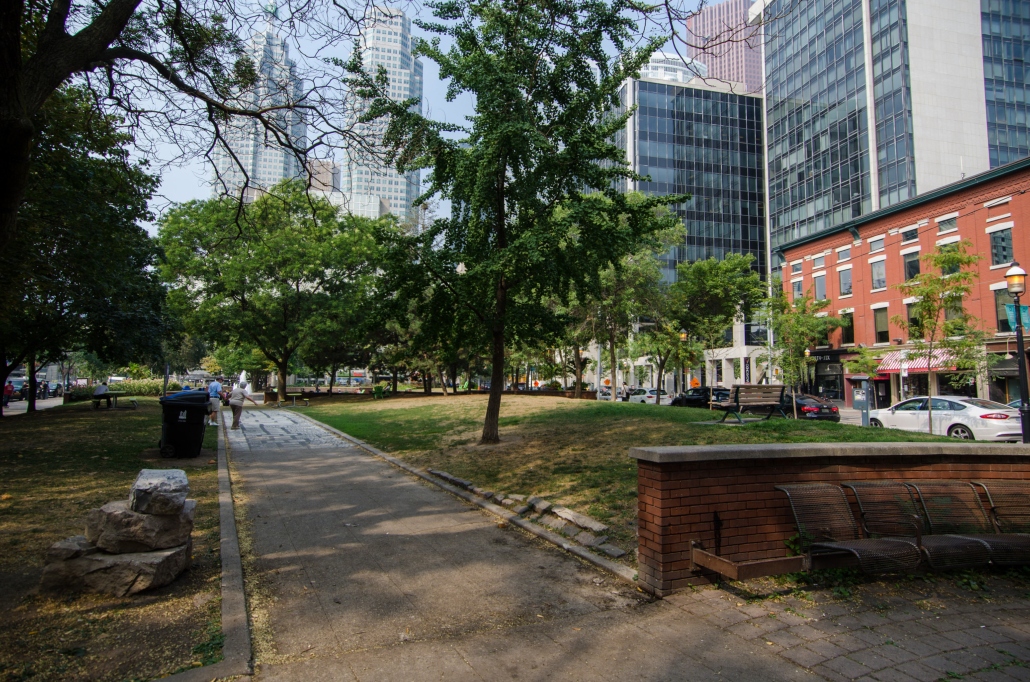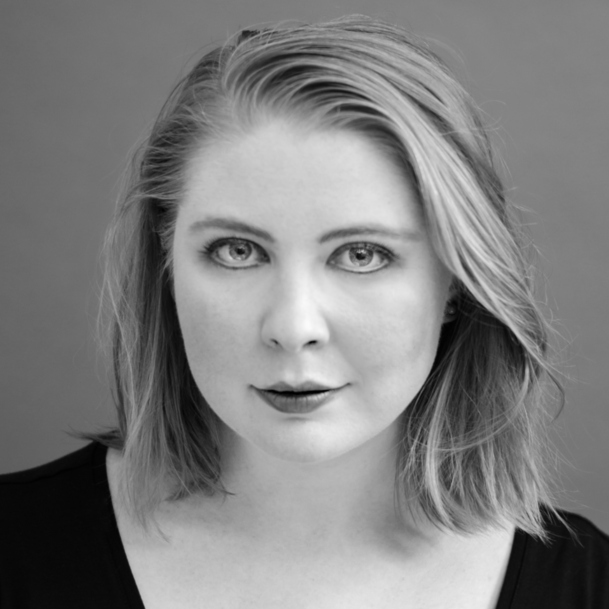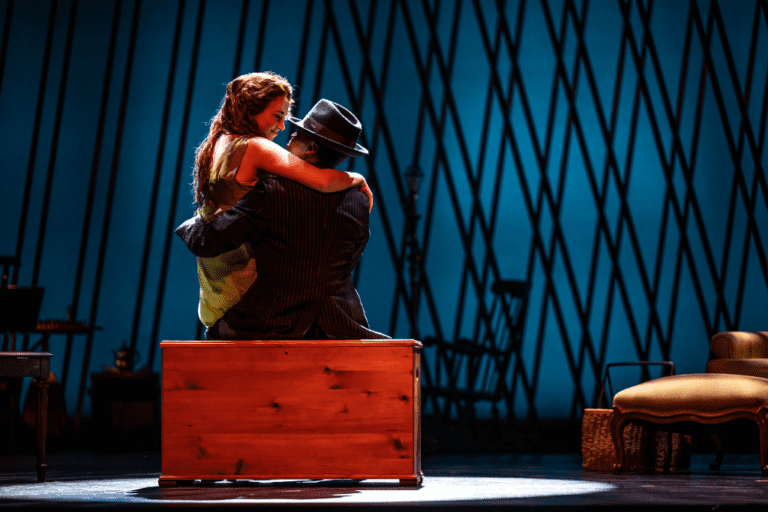Homelessness and Performing in Parks
Tonight in Toronto, more than 5000 people are homeless. About 450 of them are sleeping outside. As an artist who performs outside and who works with homeless and street-involved people, I want to talk about the realities of sharing public space with people who are not housed.
I last performed Shakespeare in a park in 2016 as Hermione in Dauntless City Theatre’s The Winter’s Tale. We performed in St. James Park, a beautiful space at King and Church. The park features structured gardens, large trees, and rolling lawns. The Winter’s Tale was an ambulatory piece in which the audience followed the action from location to location. That summer, there was a community of people living there who had no other home than the park. They were by-and-large tolerant of us using their space. Some of them were curious about who we were and what we were doing. They came over as we set up our changing tent and asked us questions. Some attended the performance every night, joining the crowd and following along for their favourite bits, peeling off when they were no longer interested, just like the tourists, students, and people going to fancy dinners who happened upon us.
As part of the staging for our production of Winter’s Tale, Hermione’s “statue” came to life in the gazebo on the west side of the park. Some nights people were sleeping in it so we played that scene on the gazebo steps. The relationship between the residents of the park and the play was not always harmonious. At the dress rehearsal, there was a physical fight near the gazebo during the statue scene. Leontes, played by Jordin Hall, took my hand as I entered and jumped to the final speech which ends in, “Hastily lead away!” Puzzled, I gestured towards Polixenes to continue. “Hastily lead away,” repeated Jordin firmly as he guided myself and the entire company to a removed area. While we were concerned for those fighting, we had the privilege of walking away. We were interlopers in the world of street politics.

Kate Werneburg and Jordin Hall in The Winter’s Tale (2016)
This summer I’ll return to a park with Dauntless to play Benedick in Much Ado About Nothing. Since my first outdoor Shakespeare, I’ve taken a job at Church of the Holy Trinity, the church behind the Eaton Centre. Holy Trinity has a strong focus on social justice. My work there as the volunteer coordinator and admin assistant brings me in contact with people who drop in to the church’s open hours. Many of the regulars are homeless or street-involved. In the year I’ve worked there, I’ve learned a lot about poverty and homelessness in Toronto on institutional and personal levels.
I sat down with one of these folks to speak about their experiences sleeping rough. They ask for anonymity and so I will refer to them as “G” and use neutral pronouns. G has a keen sense of humour, and makes witty remarks as we speak. Originally from the East Coast, they came to Toronto to pursue a career in construction. They have been homeless, on and off, for 30 years.
In winter, G sleeps in and helps set up the city’s Out of the Cold centres. In summer, they sleep outside. When I ask them about going into a shelter, “No,” G says,“the last time I went into a shelter, someone got stabbed 13 times for a pack of cigarettes. There are a lot of mental health issues in there.” I move on to sleeping in city parks, and ask what performers can do to be respectful when we spend time in those spaces. “It’s great for the entertainment value,” G says, “and great practise for you before you get into a playhouse.”
Is it a matter of respect? You have as much a right to be there as we do, it’s a public space. If you were singing your lungs out at 11 pm, that’s different (G adds with a smile).
The fact is the City of Toronto has made it illegal for people to sleep in public parks. The city doesn’t have the capacity to raid and disperse every encampment each night so people stay in the parks precariously. G tells me about camping outside one winter in a community of four people who had constructed temporary shelters on a hillside. “The site was close to the grocery store. We all had our separate living areas, but we pooled our money for food,” G says. “The police came without any warning and raided our camp. They took everything: our supplies, our water jugs, our shower-bags. We were dispersed and we had to go back downtown to fend alone.”
Within the theatre community, I had the chance to speak to Michaela Washburn, an accomplished Toronto-based actor who has experienced homelessness. Michaela became homeless in 2015 and remained so for 14 months when a trio of events left her with no place to go. In the span of a few months, her engagement ended, her father died, and she suffered a serious head injury from a partnered stretching exercise gone wrong. “I was in deep grief from the losses I had undergone,” Michaela says. “My father was the last of my immediate family to pass, so I couldn’t go home to recuperate. I had two big black eyes, one of them was swollen shut, and because I looked so sketchy, no-one would rent to me.”
Michaela continued to struggle. Her head injury made it difficult for her to be around people and to search for a home. She stayed with friends but worried about overstaying her welcome. She tried renting Air BnBs, but couldn’t afford to stay for any length of time. As a last resort, she entered the Acute Respite Care program at Sherbourne Health Centre, which was then known as the Infirmary. She stayed there for a couple of weeks to receive the care and support she needed to start her recovery.
Michaela found housing through literally the luck of a draw run by Sistering. But she was shocked by the uninhabitable state of the apartment she was offered:
“When I went to sign the lease, the place was filthy. But I thought, ‘They’ll clean it up before I move in’. When I moved in, it was still filthy. There was a cockroach infestation. Five out of the six windows didn’t work. I complained to Sistering, and thank goodness I had them, imagine if I had been fleeing violence? Or had children? Or spoke English as a second language? What would I have done? They did one spray. There were hundreds of dead cockroaches when I went back, and still live ones in the cupboard. And they wanted to charge me for the days I had been unable to live in the apartment. It was like telling someone ‘Congratulations on your new apartment! It’s just a little bit on fire. And it’s going to set your stuff on fire, and if you move, you’ll bring the fire with you.’”
Indigenous people are overrepresented in Toronto’s homeless population. As Michaela is Métis, I ask her if and how her experience of homelessness intersected with her Indigenous identity. “Across from the Infirmary, there were a high number of Indigenous people living in a park,” Michaela recalls her time recuperating in the Infirmary. “I had a conversation with the Executive Director; they were so willing to help me and support my healing, and incorporate the teachings I had been given from Anishnawbe Health—but there was nowhere for me to smudge! So I’m feeling suicidal from my head injury, and I have to go across the street to this park and I’m not supposed to feel triggered?”
Michaela made friends with the people she found living in that park. Even now, she stops by to see them when she’s passing through the area. She uses skills in ASL she learned for a show to communicate with one resident who is deaf.
Michaela wants the arts community to know this about homelessness: “Our services are abhorrent. And we don’t interact with each other with deep compassion. We don’t know what people are carrying around in their invisible knapsacks, and it’s too easy to make assumptions. I am an educated, successful performer with savings but I had two black eyes from a stretch gone bad. I didn’t look like that educated, successful performer to others.”
Michaela calls artists to consider these realities as we create, “As storytellers, we have the opportunity to shed light on untold stories, we have the power to awaken. Like Louis Riel said, ‘My people will sleep for 100 years, and when they awake, it will be the artists who give them back their spirit.’ We can tell stories not just for us, but for the broader community. Volunteering is important. There are lots of organizations like Sistering in the city who need your help.”
Artists have to hustle to work, but we need to give back. Do what you can. — Michaela Washburn
When we enter the park to perform, we enter with these dynamics already in play. As artists or citizens in good conscience, we cannot ignore them. How do we as artists, performing outside, responsibly share the space? At Dauntless, as with many other companies, we begin our pieces with a land acknowledgement. Indigenous peoples being disenfranchised from their land is in itself a form of homelessness. Nothing can proceed before this crucial step of acknowledgment is taken. We commit to making our pieces accessible on many levels: economically, physically, and more. We cast actors and build creative teams which reflect the city in which we live and create. If we are doing old plays, especially by dead white men, we carefully consider the text and edit it freely. We use sets that have minimal impact on the natural environment. We make space for people who live where we perform. We do our best to accommodate, adjust, go around, and negotiate respectfully when we need to share an immediate area.
G suggests what housed people can do to support those who are under-housed:
“If we have a peaceful movement, like in Queen’s Park, grab a tent and join us. Let your voice be heard. Support. Solidarity. Come out here and fend for a sleeping bag without your credit cards. Experience it. Like the Bible says—if your brother or sister is down, pick them up. Who’s going to listen to us? There are lots of ways to attack this problem, what’s going to win it for all of us?”

Cast members rehearsing Much Ado about Nothing in Berczy Park. Photo by Dahlia Katz.
We must take action. We must add our voices to the call that homelessness in this city is unacceptable. Write to all the political leaders who represent you. Join the monthly Toronto Homeless Memorial at Holy Trinity, the second Tuesday of every month. Get involved in your community. Volunteer. Not sure where to start? Give me a ring at Holy Trinity (but not till I’m back at my desk on August 7th). If you do nothing else, practise this: treat people you see living on the street in your neighbourhood, near your work, and in the parks you visit or perform in with dignity, kindness, and respect. Don’t use “homeless people” as a punchline. There for but the loss of a job or a loved one, a serious accident, or a mental health crisis, go you.
Berczy Park, where we’ll perform Much Ado About Nothing, is a busy one. It’s home to an enormous dog fountain. People pass through on dates, on their way to concerts, or in tour groups hunting for ghosts. I have seen people asleep under Berczy’s trees with bags of possessions tucked under their arms. I have also seen small tents set up for the night on its grassy hills. On weekends in August, our company will be part of the landscape too. Each night, we’ll walk away from the park and go home to places that feel safe and secure. Are we as a city just going to walk away from this crisis? Or can we face it and demand change? Provide support. Show solidarity. Do what you can.










Comments